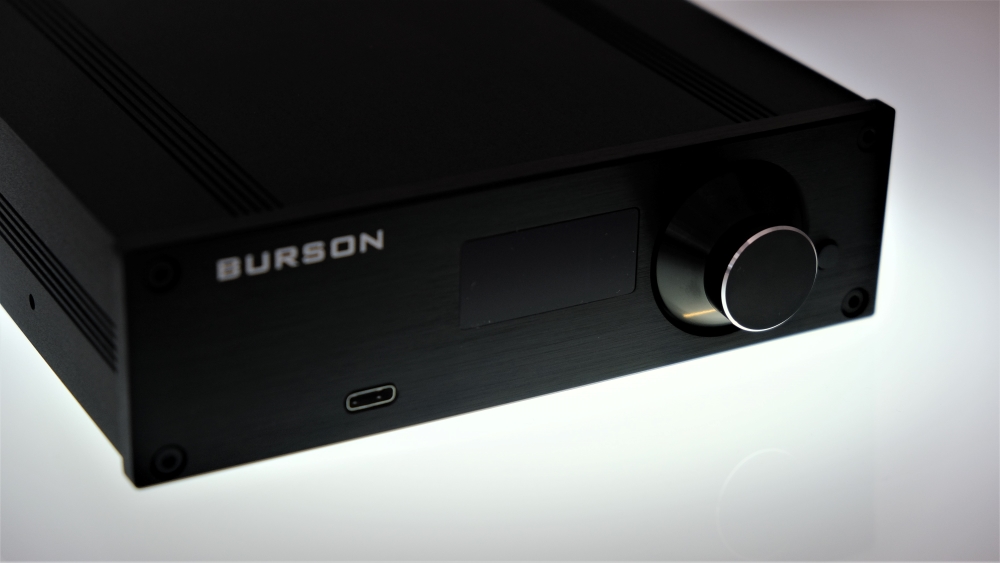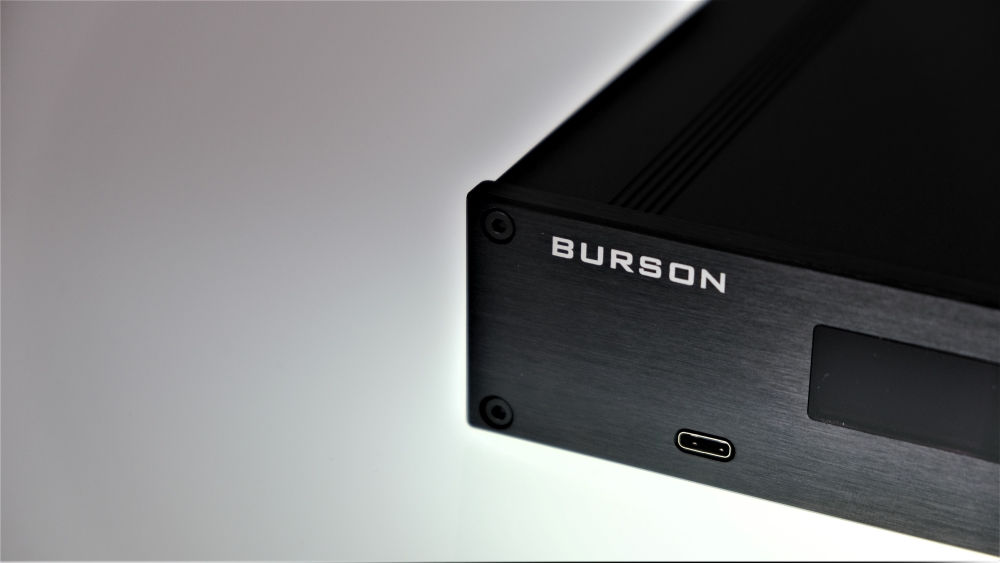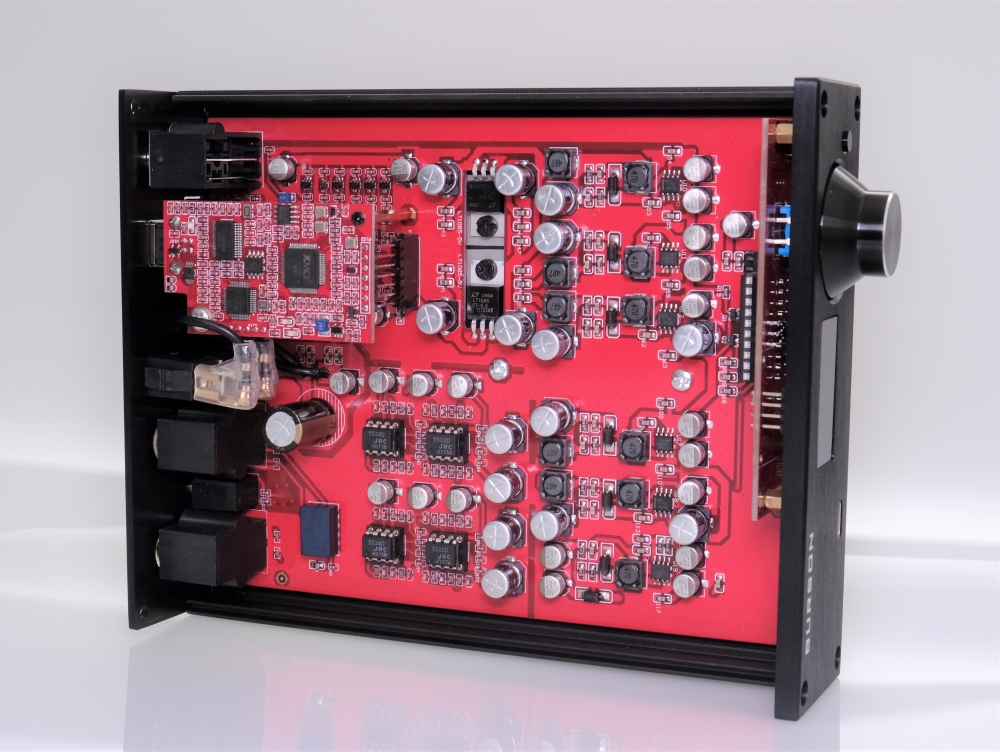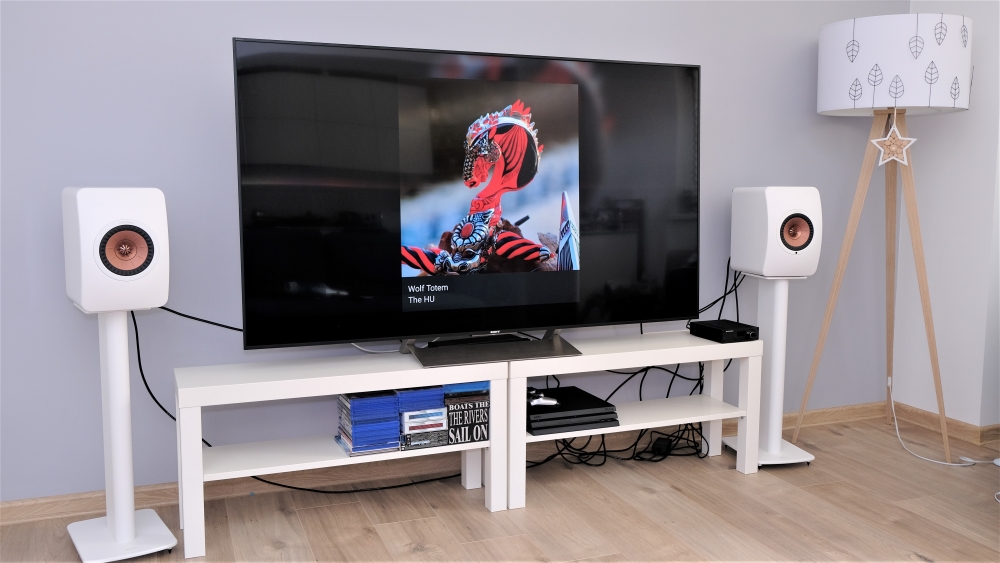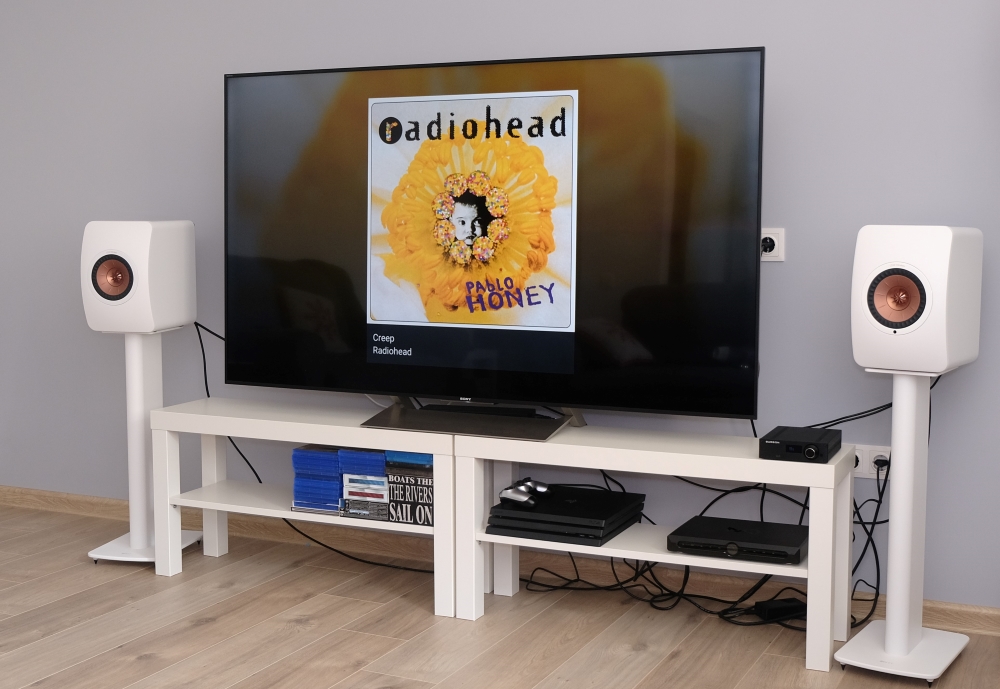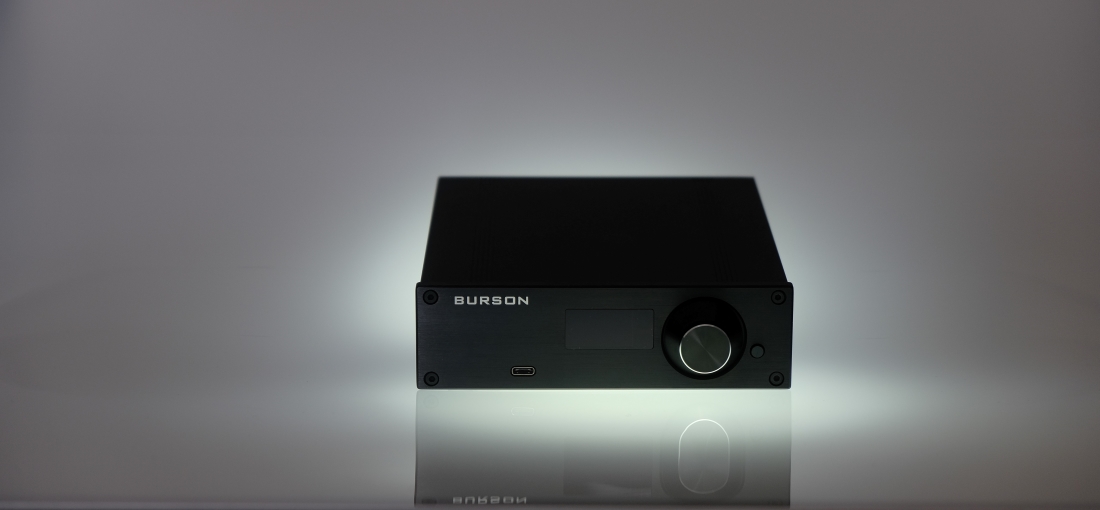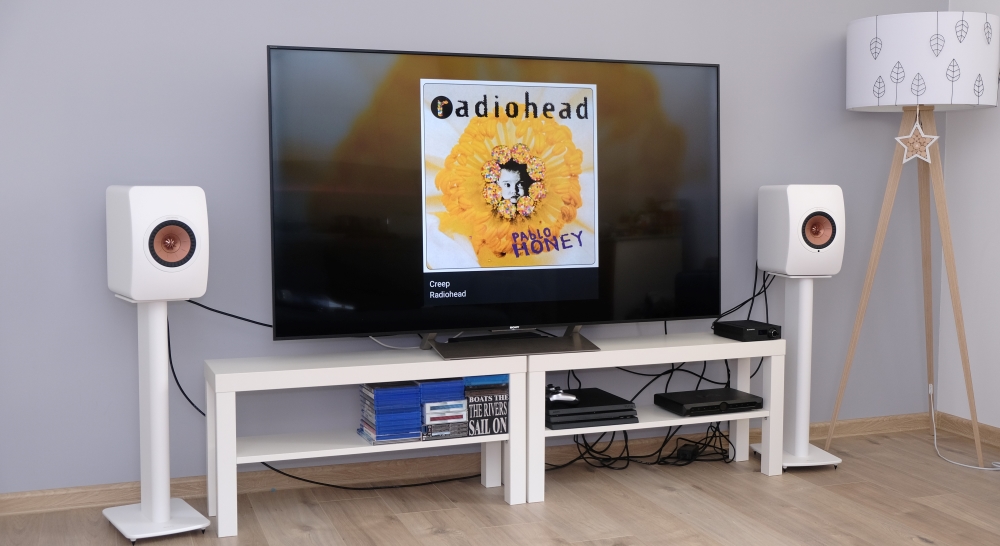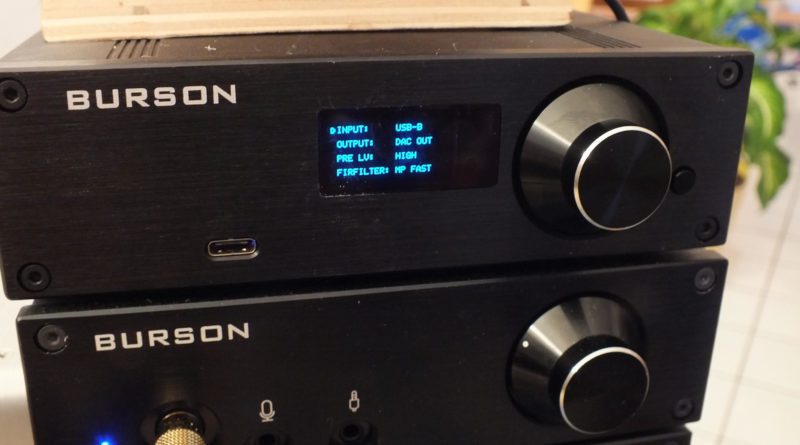I want to preface this review by stating that I own two of the Burson “PC sized” products. I got the Burson Fun and Bang from Burson as review samples. I thought they were so good that I wanted to get the Burson Swing to complete the stack. So, I ordered it along with a set of the Burson dual V6 Classics.
SETUP and SETTINGS

I’m using my Swing with the V6 Classics in I/V stage and the V6 Vivids in the LP Stage. I have the Swing set to DAC out mode and its feeding both the Burson Fun and Cavalli Liquid Carbon 2.0 at the same time with a cable splitter. I also have my favorite device in the chain, the Schiit Loki, along with the Burson Bang and Headamp Gilmore Lite Mk2. The headphones used in this review are the Focal Utopia’s and Sennheiser HD820’s. For Comparison, I have the Hugo 2.
Below are the settings I’m currently using on the Burson Swing:

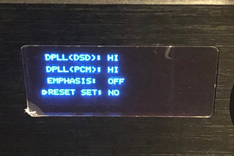
There are plenty of settings to play around with. Along with the several filters you can tryout to alter the frequency.
BUILD
Just like the Burson Fun and Bang, the Swing comes in an all-black anodized aluminum case. The Burson Swing is perfectly matched in size and stacks atop the Fun and Ban nicely. Since there are no vents to worry about, you can stack them in any order you choose.
The Burson Swing has a small display on its front panel for identifying your settings and volume it you’re using it as a pre-amp. There’s a small button next to the volume control/menu selection wheel to bring up the menu items. Once you’re in the menu you can use the volume wheel to scroll up and down to make your selection. Once you get to a menu item you want to change push the volume wheel, you’ll hear a click, to change the menu item. Once you’ve made your selection simply click the volume wheel again to get back to the menu items. To exit the menu screen, you can do nothing and the Swing will automatically revert back to the home screen or you can push the menu button and exit quicker. There’s also a USB-C input on the front of the Swing.
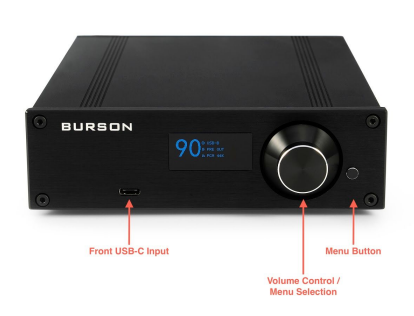
On the rear of the Burson Swing you have a separate pre-out and DAC out outputs. This is a great feature. It allows you to connect the Swing to a power amp directly and control the volume. At the same time, you can connect it to a headphone amp as a DAC only with fixed volume. This saves you from having to access the back panel all time a switching cables from one output to the other. All you have to do is change settings in the menu and off you go. You have the both coax and toslink digital inputs. Along with a USB-B input for PC, phone and tablet connectivity. Lastly there’s an 12V DC connection for internal PC use if you choose to house the Swing in a PC.

The Swing uses the ESS SABRE ES9038Q2M DAC chip. Combined with the Xmos USB receiver it’s capable of delivering PCM audio up to 32bit/768khz and DSD audio up to DSD512. Not bad for such a small package.
Internally, the Swing is well laid out and designed. It uses 2 x single and 2 x dual op-amps that are interchangeable to tailor the sound to your liking. It also using 6 Max Current Power supplies which is uniquely Burson. This is a breakaway from conventional transformers and is the main reason Burson can house such great sounding products in such diminutive size.

SOUND
I really love how Burson has voiced the Swing. SABRE DACs in general are known to be harsh, bright and dry sounding. I detect none of these qualities in Swing. All is hear is the music when I plug in my headphones. The background is black when paired with the Fun, GL Mk2, or LC 2.0. The sound is natural, engaging, and full bodied. Using the Swing with GL Mk2 and going balanced directly from the Bang with Sparkos SS3602 op-amps the bass on the HD820’s hits hard and has plenty of depth. Vocals sounds so smooth and appealing. The treble with the HD820 has the right amount of sparkle and clarity. The sound is balanced no matter what music genre I was listening too. The Swing does nothing to take away from the wide soundstage of the HD20’s. It adds depth and very good instrument separation and layering to it. If you can’t tell by now the HD820 are my favorite Sennheiser headphones even if they are closed headphones.
Listening to the Utopia’s using the Swing and LC 2.0. Immediately you get a more intimate sound. The soundstage is nowhere near as wide as the HD820’s. But clarity and timbre still stand out. With the Utopia’s the Swing brings its musical qualities to the table. The bass is rich, the mids are more balanced sounding and the treble detail of the Utopia’s are in full swing! The sound is clean, dynamic and powerful.
COMPARISONS
The Hugo 2 is my favorite DAC to date. It renders music a little differently than the Burson Swing. The notes in the music are more detailed and defined. It has more transparency and doesn’t add much of its own sound signature to the music. The Swing, with the V6 Classics and Vivids sounds colored in comparison but not in a bad way. The detail is still there but it doesn’t sound as open and expansive as the Hugo 2. The Swing is smoother and warmer. It’s also more enjoyable with bad recordings. The Hugo 2 does nothing to alter the sound of bad recordings. If recording is bad the Hugo 2 can be rough listen. But with darker sounding headphones, like anything from Audeze, the Hugo 2 is a great compliment to their sound.
The Swing, on the other hand, is great with brighter sounding gear, like Audio-Technica, Focal, and Hifiman. It adds a musicality to them that is so pleasing. Instead of competitors I find the Swing to be a nice compliment to the Hugo 2. When I listen to the Susvara’s on the Bang with the Swing as the DAC the sound is so submersive. It’s same with the HD820’s. I’m not sure if it’s the Bang with the Sparkos SS3602 and the extra driving power or the Swing with the V6 Classics and Vivids. Butt the combination with Susvara’s is amazing.
In closing, the Swing is an outstanding product and can compete with higher end gear. It loses out in ultimate detail retrieval. The Swing more than makes up for it in its musical delivery. If you’re on a budget and need a really great DAC the Swing is a must listen in my opinion. Outfitting the Swing with upgraded op-amps makes it an even better buy and you still won’t break the bank. Well done Burson…..
UPDATE 11.7.19
I received a set of the dual V6 vivids from Burson to tryout. The first thing I did was listen to the Burson Swing in my current configuration with the V6 classics in the I/V stage and the V6 vivids in the LP stage to get a feel for the sound. Then I inserted the V6 vivids into the IV stage to do some listening. The rest of the gear in my demo session was the Burson Bang with Sparkos SS3602 op-amp, Headamp Gilmore Lite Mk2, and Shiit Loki. Headphones used were my ZMF Auteurs.
The first thing I noticed with the V6 vivids in the mix was the sound became livelier. The sound was more detailed and transparent and the bass had more impact. There was more clarity in the treble. There was also a crispness to the sound that wasn't there with the V6 classics inserted. Gone is the touch of musicality that the V6 classics provided. There is also a loss of midrange fullness/body that the V6 classics provide. The bass bloom from the V6 classics is gone and replaced with more definition and speed. I'm not sure which sound I like more after finally hearing an all V6 vivid setup.
The all V6 vivid setup in the Burson Swing is very comparable to the sound of my Hugo 2, which is high praise. The dynamics are similar, the soundstage width is similar but the soundstage depth goes to the Hugo 2. The Hugo 2 is also slightly more transparent and offers a bit more insight into the music. But the Burson Swing gets you 85-90% there at a fraction of the cost of the Hugo 2.
The Burson Swing is a very underrated product. Despite the basic looks on the outside the internals are well laid out and contain a wealth of technology and innovation. Burson has taken the ESS DAC chips and turn them into a musical force. The way Burson has implemented and integrated the ESS DAC chips into the Swing is phenomenal. The Burson Swing has synergy with all the amps I've paired it with. My Cavalli Liquid Carbon 2.0, Gustard H20, and Burson's own Fun all sound superb with the Burson Swing performing DAC duties. From novelist head-fier to audiophiles the Burson Swing is a worthy listen.
SETUP and SETTINGS

I’m using my Swing with the V6 Classics in I/V stage and the V6 Vivids in the LP Stage. I have the Swing set to DAC out mode and its feeding both the Burson Fun and Cavalli Liquid Carbon 2.0 at the same time with a cable splitter. I also have my favorite device in the chain, the Schiit Loki, along with the Burson Bang and Headamp Gilmore Lite Mk2. The headphones used in this review are the Focal Utopia’s and Sennheiser HD820’s. For Comparison, I have the Hugo 2.
Below are the settings I’m currently using on the Burson Swing:


There are plenty of settings to play around with. Along with the several filters you can tryout to alter the frequency.
BUILD
Just like the Burson Fun and Bang, the Swing comes in an all-black anodized aluminum case. The Burson Swing is perfectly matched in size and stacks atop the Fun and Ban nicely. Since there are no vents to worry about, you can stack them in any order you choose.
The Burson Swing has a small display on its front panel for identifying your settings and volume it you’re using it as a pre-amp. There’s a small button next to the volume control/menu selection wheel to bring up the menu items. Once you’re in the menu you can use the volume wheel to scroll up and down to make your selection. Once you get to a menu item you want to change push the volume wheel, you’ll hear a click, to change the menu item. Once you’ve made your selection simply click the volume wheel again to get back to the menu items. To exit the menu screen, you can do nothing and the Swing will automatically revert back to the home screen or you can push the menu button and exit quicker. There’s also a USB-C input on the front of the Swing.

On the rear of the Burson Swing you have a separate pre-out and DAC out outputs. This is a great feature. It allows you to connect the Swing to a power amp directly and control the volume. At the same time, you can connect it to a headphone amp as a DAC only with fixed volume. This saves you from having to access the back panel all time a switching cables from one output to the other. All you have to do is change settings in the menu and off you go. You have the both coax and toslink digital inputs. Along with a USB-B input for PC, phone and tablet connectivity. Lastly there’s an 12V DC connection for internal PC use if you choose to house the Swing in a PC.

The Swing uses the ESS SABRE ES9038Q2M DAC chip. Combined with the Xmos USB receiver it’s capable of delivering PCM audio up to 32bit/768khz and DSD audio up to DSD512. Not bad for such a small package.
Internally, the Swing is well laid out and designed. It uses 2 x single and 2 x dual op-amps that are interchangeable to tailor the sound to your liking. It also using 6 Max Current Power supplies which is uniquely Burson. This is a breakaway from conventional transformers and is the main reason Burson can house such great sounding products in such diminutive size.

SOUND
I really love how Burson has voiced the Swing. SABRE DACs in general are known to be harsh, bright and dry sounding. I detect none of these qualities in Swing. All is hear is the music when I plug in my headphones. The background is black when paired with the Fun, GL Mk2, or LC 2.0. The sound is natural, engaging, and full bodied. Using the Swing with GL Mk2 and going balanced directly from the Bang with Sparkos SS3602 op-amps the bass on the HD820’s hits hard and has plenty of depth. Vocals sounds so smooth and appealing. The treble with the HD820 has the right amount of sparkle and clarity. The sound is balanced no matter what music genre I was listening too. The Swing does nothing to take away from the wide soundstage of the HD20’s. It adds depth and very good instrument separation and layering to it. If you can’t tell by now the HD820 are my favorite Sennheiser headphones even if they are closed headphones.
Listening to the Utopia’s using the Swing and LC 2.0. Immediately you get a more intimate sound. The soundstage is nowhere near as wide as the HD820’s. But clarity and timbre still stand out. With the Utopia’s the Swing brings its musical qualities to the table. The bass is rich, the mids are more balanced sounding and the treble detail of the Utopia’s are in full swing! The sound is clean, dynamic and powerful.
COMPARISONS
The Hugo 2 is my favorite DAC to date. It renders music a little differently than the Burson Swing. The notes in the music are more detailed and defined. It has more transparency and doesn’t add much of its own sound signature to the music. The Swing, with the V6 Classics and Vivids sounds colored in comparison but not in a bad way. The detail is still there but it doesn’t sound as open and expansive as the Hugo 2. The Swing is smoother and warmer. It’s also more enjoyable with bad recordings. The Hugo 2 does nothing to alter the sound of bad recordings. If recording is bad the Hugo 2 can be rough listen. But with darker sounding headphones, like anything from Audeze, the Hugo 2 is a great compliment to their sound.
The Swing, on the other hand, is great with brighter sounding gear, like Audio-Technica, Focal, and Hifiman. It adds a musicality to them that is so pleasing. Instead of competitors I find the Swing to be a nice compliment to the Hugo 2. When I listen to the Susvara’s on the Bang with the Swing as the DAC the sound is so submersive. It’s same with the HD820’s. I’m not sure if it’s the Bang with the Sparkos SS3602 and the extra driving power or the Swing with the V6 Classics and Vivids. Butt the combination with Susvara’s is amazing.
In closing, the Swing is an outstanding product and can compete with higher end gear. It loses out in ultimate detail retrieval. The Swing more than makes up for it in its musical delivery. If you’re on a budget and need a really great DAC the Swing is a must listen in my opinion. Outfitting the Swing with upgraded op-amps makes it an even better buy and you still won’t break the bank. Well done Burson…..
UPDATE 11.7.19
I received a set of the dual V6 vivids from Burson to tryout. The first thing I did was listen to the Burson Swing in my current configuration with the V6 classics in the I/V stage and the V6 vivids in the LP stage to get a feel for the sound. Then I inserted the V6 vivids into the IV stage to do some listening. The rest of the gear in my demo session was the Burson Bang with Sparkos SS3602 op-amp, Headamp Gilmore Lite Mk2, and Shiit Loki. Headphones used were my ZMF Auteurs.
The first thing I noticed with the V6 vivids in the mix was the sound became livelier. The sound was more detailed and transparent and the bass had more impact. There was more clarity in the treble. There was also a crispness to the sound that wasn't there with the V6 classics inserted. Gone is the touch of musicality that the V6 classics provided. There is also a loss of midrange fullness/body that the V6 classics provide. The bass bloom from the V6 classics is gone and replaced with more definition and speed. I'm not sure which sound I like more after finally hearing an all V6 vivid setup.
The all V6 vivid setup in the Burson Swing is very comparable to the sound of my Hugo 2, which is high praise. The dynamics are similar, the soundstage width is similar but the soundstage depth goes to the Hugo 2. The Hugo 2 is also slightly more transparent and offers a bit more insight into the music. But the Burson Swing gets you 85-90% there at a fraction of the cost of the Hugo 2.
The Burson Swing is a very underrated product. Despite the basic looks on the outside the internals are well laid out and contain a wealth of technology and innovation. Burson has taken the ESS DAC chips and turn them into a musical force. The way Burson has implemented and integrated the ESS DAC chips into the Swing is phenomenal. The Burson Swing has synergy with all the amps I've paired it with. My Cavalli Liquid Carbon 2.0, Gustard H20, and Burson's own Fun all sound superb with the Burson Swing performing DAC duties. From novelist head-fier to audiophiles the Burson Swing is a worthy listen.



























